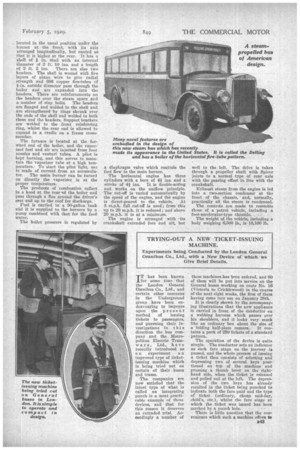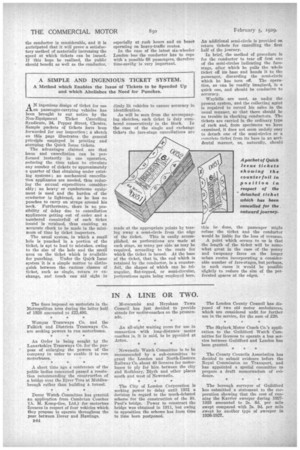TRYING-OUT A NEW TICKET-ISSUING MACHINE.
Page 27

Page 28

If you've noticed an error in this article please click here to report it so we can fix it.
Experiments being Conducted by the London General Omnibus Co., Ltd., with a New Device of which we Give Brief Details.
IT has been known for some time that the London General Omnibus Co., Ltd., and certain other concerns in the Underground group have been endeavouring to improve upon the present method of issuing tickets to passengers, and pursuing their investigations in this direction the bus company and the Metropolitan Electric Tramways, Ltd., have recently introduced as
n experiment a n improved type of ticketissuing machine which Is being tried out on certain of their buses and trams.
The companies are now satisfied that the latest type of what is called an integrating punch is a most practicable example of these devices, and that for this reason it deserves an extended trial. Accordingly a number of
these machines has been ordered, and 00 of them will be put into service on the General buses working on route No. 16 (Victoria to Cricklewood) in the course of the next eight weeks, the first of them having come into use on January 28th.
It is clearly shown by the accompanying illustrations that the new appliauce is carried in front of the conductor on a webbing harness which passes over his shoulders, and it looks very much like an ordinary box about the size of
a folding half-plate camera. It contains a pack of 250 tickets of a standard pattern.
The operation of the device is quite simple. The conductor sets an indicator as each fare stage on the journey is passed, and the whale process of issuing a ticket then consists of selecting and depressing two of several keys positioned on top of the machine and pressing a thumb lever on the righthand side, when the ticket is released and pulled out at the left. The depression of the two keys has already resulted in the ticket being punched to indicate both the fare paid and the type of' ticket (ordinary, cheap mid-day, child's, etc.), whilst the fare stage at which the ticket was issued has been marked by a punch hole.
There is little question that the convenience which such a machine offers to B43
the conductor is considerable, and it is anticipated that it will prove a satisfactory method of materially increasing the speed at which tickets can be issued. if this hope be realized, the public should benefit as well as the conductor,
especially at rush hours and on busesoperating on heavy-traffic routes.
In the ease of the latest six-wheeler London bug the conductor has to cope with a possible 68 passengers, therefore time-eaviag is very important.


































